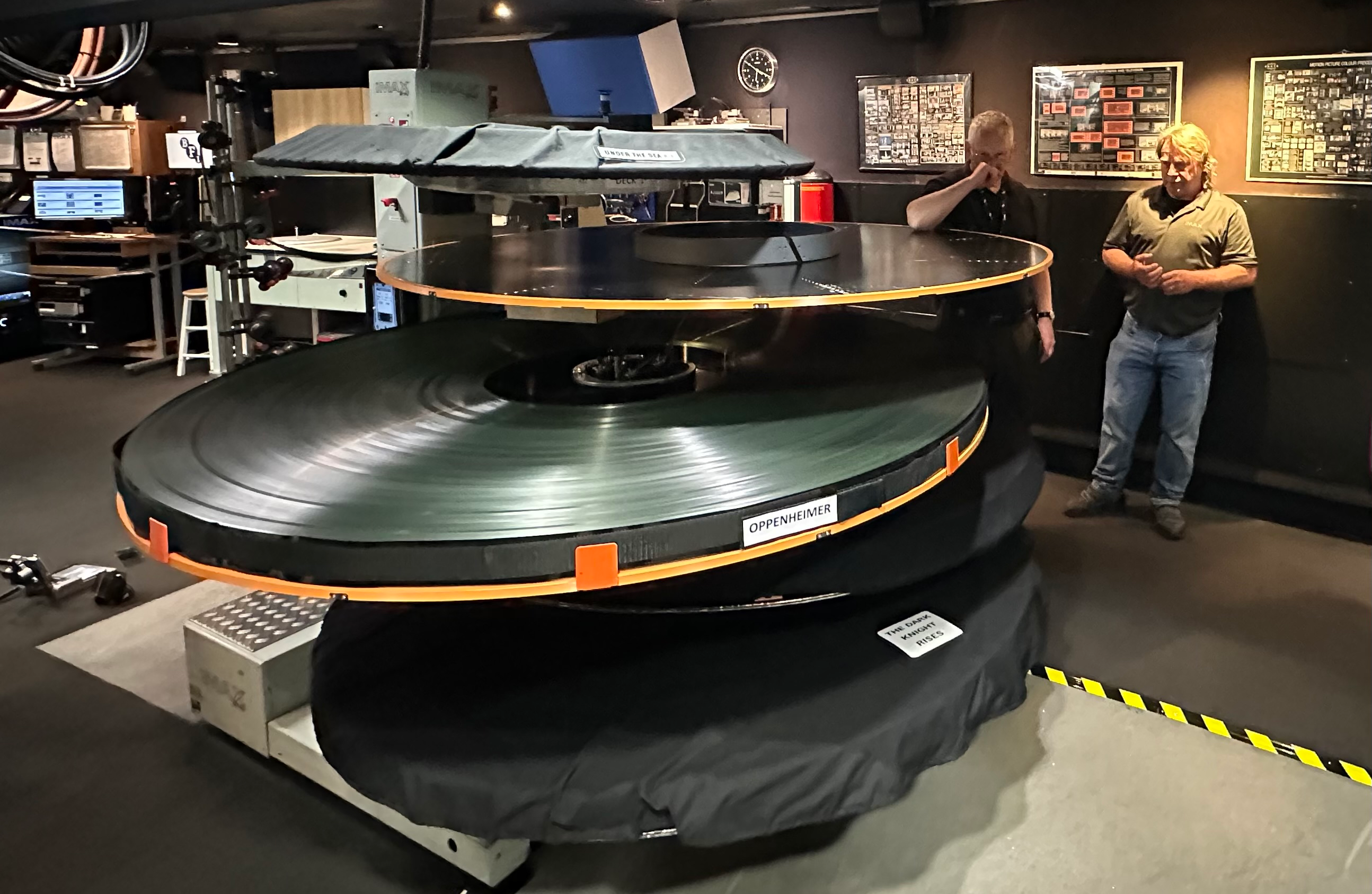Digital filmmaking and projection have been how we experience movies in theaters since the early 2000s. In fact, 12 years ago Kodak was very close to discontinuing IMAX 1570mm film in the face of the changed cinema landscape. But director Christopher Nolan, along with IMAX’s chief quality officer, David Keighley, and his wife, IMAX chief quality guru Patricia Keighley, convinced Kodak to keep making it because they saw a future in it. Since then, Nolan and IMAX have worked together to make and present films using the 1570 format, including “The Dark Knight,” “The Dark Knight Rises,” “Interstellar,” “Dunkirk,” and “Tenet.” But “Oppenheimer” has ushered in the vintage technology’s renaissance.
If you were one of the lucky ones who saw “Oppenheimer” at the TCL Chinese Theatre last summer, I was one of the projectionists running it and bore witness to it becoming the highest-grossing in the theater’s history. Much of the fanfare my fellow projectionist Pat Caldwell and I witnessed wasn’t just about the movie but about the IMAX 1570 technology, as we gave a whole lot of tours of our tiny booth.
The process of bringing Nolan’s masterpiece to the Chinese and 29 other theaters around the world took months of planning and coordination between IMAX, Universal—the film’s distributor—participating theaters, and Nolan. Old IMAX 1570 equipment set aside as museum pieces of a bygone era, like the GT and SR projectors, Quick-Turn Reel Units, and the DDP and DTAC sound-synching systems received tune-ups and upgrades, and were shipped off to theaters. Former IMAX projectionists like myself were brought out of retirement and assigned the theater in which we would be working.
After the Chinese installed the IMAX SR projection system specifically for “Oppenheimer,” a temporary plywood booth was built around it, located at the back of the main auditorium. I spent many hours in those darkened, claustrophobic quarters during a five-week period to ensure a seamless theatrical experience.
Here’s the magic of seeing an IMAX 1570 mm film. While you were in the theater, eating your popcorn and watching “Oppenheimer,” a culmination of literal and metaphorical moving parts happened behind the scenes to make your movie-watching experience a memorable one. Six hundred pounds and 11 miles of film is spinning around at insanely fast speeds on giant aluminum platters that could send you to the hospital if you unwisely put any part of your body in their way.
It’s being fed from one platter via a feed unit, through a roller coaster array of precisely-placed rollers, entering the input side of the 2-ton, almost 6-foot projector, then fed through the output side, back through more strategically placed rollers and a carefully calibrated extension arm that then feeds the film back onto the other platter. This all happens at a speed of 5.5 feet per second or, for you film nerds, 24 frames per second.
While the film is fed through the projector, it’s held in place by a series of gates and stators in a “rolling loop.” The loop is what helps move the film as it passes over sprockets (this is where the 15 in 1570 comes from – 15 sprocket holes per 70 mm frame) as it glides along the giant, whirling rotor on a consistently blowing cushion of air. Without that loop, the film would be destroyed inside the projector, causing the entire system to shut down. IMAX 1570 film requires around 50 percent humidity in the room, so we had to keep a constant eye on the humidity levels. If the booth becomes too dry, the film begins to crinkle, potentially causing the movie to crash. All of this and so much more was going on inside the booth, and you, the moviegoer, had no idea.
You might have seen a slight flicker while watching “Oppenheimer.” That flickering is part of what makes the IMAX 1570 film experience so different, as if the movie is alive and breathing. This happens because the film isn’t continuously flowing through the projector; rather, each frame is paused just long enough to be illuminated by the 7,000-watt Xenon quartz lamp. So that flicker is actually each frame of film being stopped momentarily in front of the lamp.
Were there a few minor imperfections onscreen during your “Oppenheimer” viewing? That’s how you know you’re getting an authentic 1570 print. Besides the usual wear and tear of running print film, this can also be chalked up to what Keighley describes as a complete photochemical finish, which means shooting on film, cutting the negative and using it to strike prints. So whatever imperfections are in the original negative, you’ll see that on screen. But all of this means a richer movie experience. So when you see the Trinity Test with that magnificent, full-screen explosion, or any of the black-and-white scenes, you’re experiencing a depth that can’t be replicated in digital. Keighley says that Nolan is the only person who does this: “That’s the gold standard, and that’s what he loves so much. He loves the organic feel of IMAX 1570.”
So, this begs the question: What’s the future like for IMAX 1570 film? Keighley says that Nolan would certainly love to continue using it for his films. And while Denis Villeneuve didn’t shoot “Dune 2” with IMAX 1570 film, it was shot with IMAX digital cameras and will be shown in print format. Villeneuve credits the success of “Oppenheimer” with making that happen. “We continue to keep the pipeline alive,” says Keighley. “It’s a complex pipeline, but when there’s a powerful filmmaker like Chris, and now Denis, to help all of the logistics come together, then we’ll continue to make more films using the IMAX 1570 film format.”



